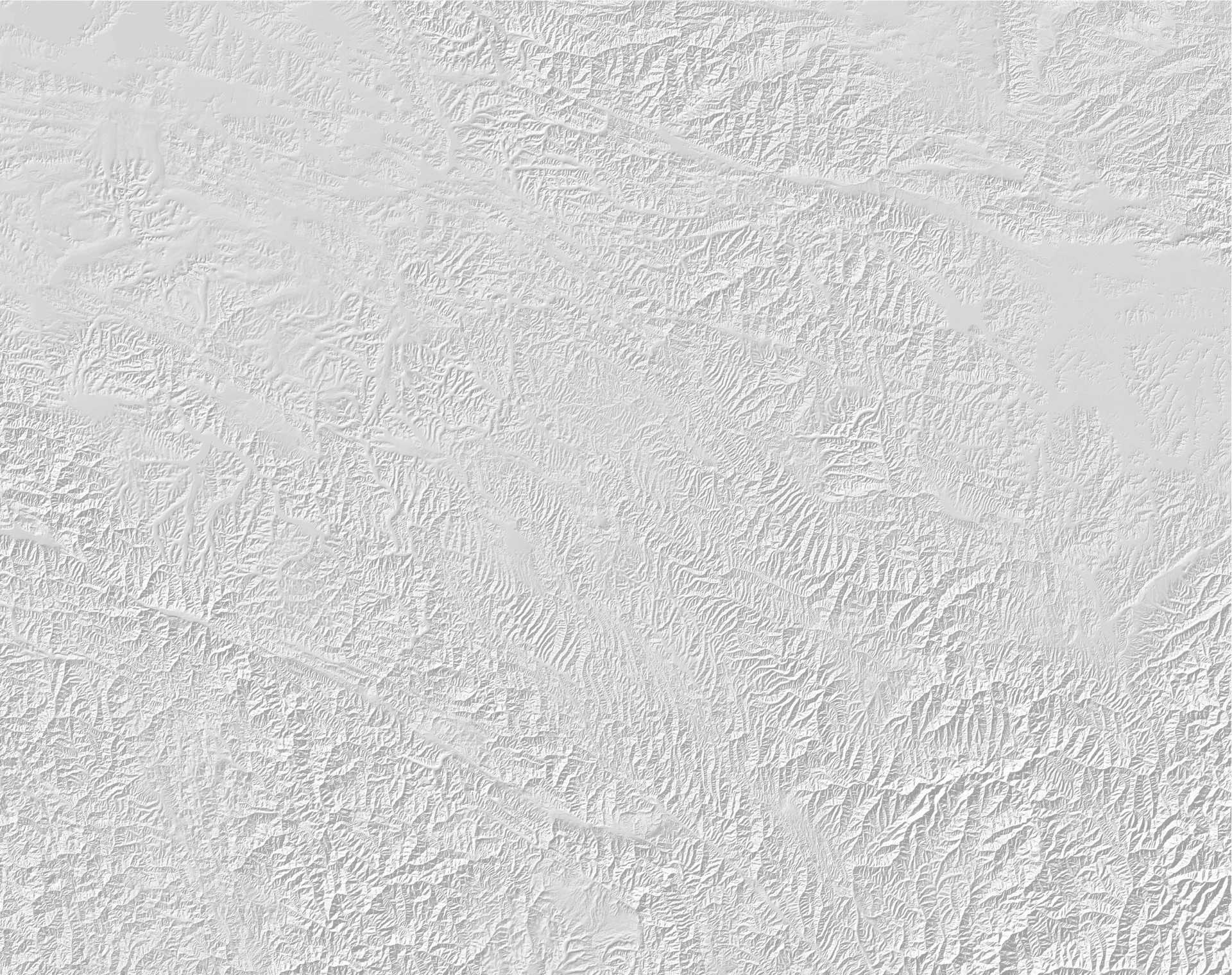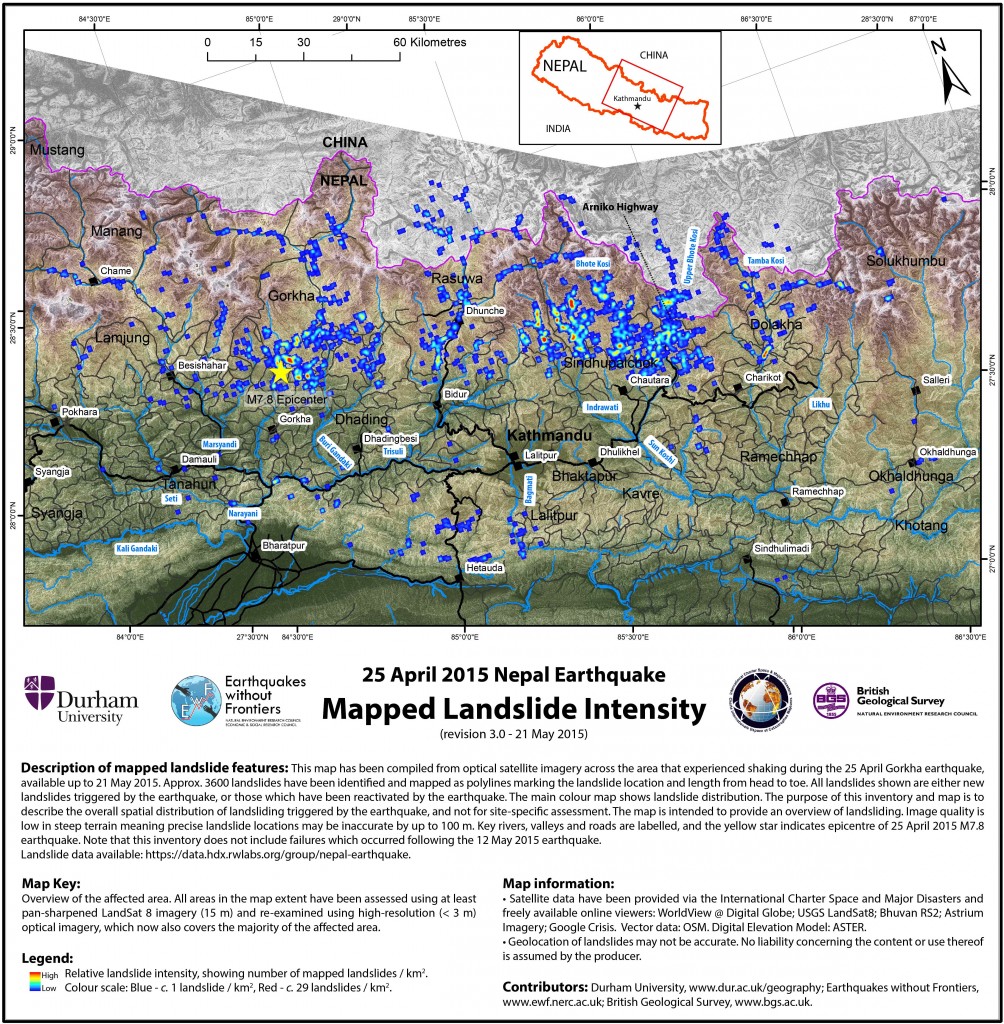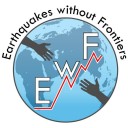Nepal: UPDATED (28 May) landslide inventory following 25 April Nepal earthquake
Please note: This is an updated landslide density map following the 25 April earthquake in Nepal. The inventory does not yet include failures triggered or reactivated by the 12 May 2015 earthquake.
Key messages (all observations based on available cloud free satellite imagery):
- Approximately 3,600 landslides have been identified to date including new landslides triggered by the 25 April 2015 earthquake and landslides which have been reactivated by the 25 April earthquake and aftershocks up to 12 May 2015.
- Major or disruptive landsliding is limited to a zone that runs east-west, approximately parallel to the transition between the Lesser and High Himalaya. This zone includes parts of the districts of Gorkha, Dhading, Nuwakot, Rasuwa, Sindhupalchok, Dolakha, Ramechhap, and Khavre.
- We observe several large valley-blocking landslides. Most observed landslides comprise comparatively small rockfalls and debris avalanches that have a significant local impact and loss of life. The risk of valley-blocking landslides persists as earthquake damaged slopes may collapse into river channels, as witnessed on the Kali Gandaki on 24 May.
- The need to plan measures to mitigate landslide hazards and disruption in the forthcoming monsoon season must remain a priority. Many more damaging landslides may occur in the 2015 monsoon, likely to start in early June, than would be expected if a major earthquake had not occurred.
- There have been numerous reports of cracked ground in the affected areas. There is no single interpretation of cracks in slopes generated during earthquakes and how these cracks are likely to develop through the monsoon. We recommend establishing simple monitoring (distance measurements between stakes positioned across cracks), to establish if cracks are widening or if movement of the slope has ceased. Areas that exhibit continued or accelerating movement should be treated with extreme caution.
Background and methodology
The purpose of this inventory and map is to describe the overall spatial distribution of landsliding triggered by the earthquake, not for site-specific assessment. The image quality is low in steep terrain meaning precise landslide locations may be inaccurate by up to 100 m. The landslides have been identified and mapped using optical satellite imagery across the area that experienced shaking during the 25 April Gorkha earthquake, available up to and including 21 May 2015, in addition to some reports from the ground where available. All landslides have been mapped as lines that start at the crest and trace the landslide path to its toe. The colour on the map shows the frequency of mapped landslides per km2, ranging from 1 to a maximum of 29, to illustrate the region wide landslide intensity. Key rivers, valleys and roads are labelled, and the yellow star indicates epicentre of 25 April 2015 M7.8 earthquake.
Landslide data can be downloaded from: https://data.hdx.rwlabs.org/group/nepal-earthquake.
Satellite data have been provided via the International Charter Space and Major Disasters and freely available online viewers: WorldView @ Digital Globe; USGS LandSat8; Bhuvan RS2; Astrium Imagery; Google Crisis. Vector data: OSM. Digital Elevation Model: ASTER.
District level landslide maps
The individual landslide features mapped are also provided on District level maps for:
- Dolakha
- Gorkha
- Nuwakot
- Rasuwa
- Sindhupalchok
All maps, and the current landslide shapefile (23.05.15), are available to download from the following website: ftp://topdog.dur.ac.uk/njr/nepal_eq/UPDATE_20150522/
Regional update:
Siwalik and Lesser Himalayan regions
- We have high confidence that there are few very large landslides, beyond those widely reported at higher altitudes (see below). Whilst locally destructive, most landslides are relatively small; many are re-activations.
- Analysis of villages/infrastructure known to have been damaged by landslides shows that the latter are almost all small and extremely difficult to identify using the available imagery.
High Himalayan region
- We, and various other groups, have identified several large valley-blocking landslides (landslide dams) on the basis of satellite imagery (see: ICIMOD). We stress that further valley-blocking landslides may still be found as additional imagery on currently cloud covered areas becomes available; other areas in the High Himalayas should be assumed to be at risk until the existence of landslide dams can be confirmed or ruled out.
- There remains a significant continued risk of new or reactivated landslides blocking river valleys, such as that seen in the Kali Gandaki on 24 May. Such landslides may occur without an apparent trigger.
- A zone of relatively intense landsliding and disruption can be mapped in every valley for which cloud-free imagery is available, northwest, north and northeast of Kathmandu, running from Gorkha to Dolakha districts. This zone contains numerous rockfalls and debris avalanches, with many events following pre-existing pathways or channels and having long runout distances (in most cases, all the way to the valley floor). These events are individually localised but together are extremely widespread, and have had catastrophic impacts on roads and villages. It is these small, but widespread, landslides that are likely to have caused the largest loss of life due to landsliding.
- Cloud-free images are not yet available for all valleys within this zone; until they are, we must expect that similar levels of disruption are present in ALL valleys within the zone, not just those indicated in the map.
- Where visible, high-elevation areas (> 3,500 m) show evidence of rockslides, along with extensive avalanching (the latter especially above 4,500 m). Most of these areas are far from permanent settlements or infrastructure, and pose no direct threat to the population.
Entire earthquake affected region
- The zone of intense landsliding approximately maps onto the areas with the highest seasonal monsoon rainfall, and those areas with the highest annual fatalities due to rainfall-triggered landslides (see: Dave Petley’s landslide blog). We must therefore expect that the risk due to continued landsliding in this area will escalate significantly as the rains begin. This continued landslide occurrence will threaten already-affected areas with continued failure, and will wash landslide sediment downstream onto valley floors and floodplains.
- The monsoon is expected to begin in early June, moving from east to west to cover the whole of Nepal by the end of June (see: Dave Petley’s landslide blog).
Landslides and major roads
- The Arniko Highway (north to Tibet) is reported to be at continued high risk of landsliding from near Chaku to the Tibetan border. Many towns and villages in the valley bottom appear to have been abandoned. This area has had chronic landslide problems prior to the earthquake, and the road is regularly impassable during the monsoon. The pre-existing Sun Koshi landslide dam that crossed the Arniko Highway at Jure appears intact, following all earthquakes up to 25 May 2015.
- The Prithvi Highway (the main route from Kathmandu south to India) has also experienced ongoing landslide problems since the earthquake, including large rockfalls onto the road. This road has suffered extensive landsliding in the past. In August 2000 a single landslide blocked the road for 11 days, leading to severe shortage of fuel and other commodities in the metropolitan area.
Recommendations
- Before the onset of the monsoon, the potential valley-blocking landslides and heavily-impacted valleys should be inspected and monitored to assess the risk of landslide dam formation and further risk of failure during the monsoon. At present, there does not appear to be a high risk of imminent failure in any known dams that may severely impact valleys downstream, but this may change with new or reactivated landslides. The recent landslide which blocked the Kali Gandaki River in Myagdi District, breaching rapidly on 24 May, highlights the importance of regular monitoring and inspections in all valleys in the affected area.
- Road access to, and through, the zone of intense landsliding is going to be very challenging at least through the 2015 monsoon season. This is both on major road corridors but also on seasonally accessible roads, which are likely to be in a heightened state of damage. It would be sensible to undertake a continuous survey of the major transportation corridors to identify where new problems are most likely to arise, problems are developing, and to prepare for the possibility of BOTH immediate action to clear rockfall debris AND continued clearance and maintenance of major roads after future landsliding. Note that all major roads to China in the affected area appear heavily impacted.
- Collation of observations of the distribution, character and impact of landslides from people in the field is required to refine landslide hazard and risk assessments and validate the findings of the satellite-based survey we have undertaken. We have already instigated a social-media call to initiate this, but additional measures may be required, and a method of collation agreed. We note that field teams from Tribhuvan University and ICIMOD, and USGS are collecting data at present.
- There have been numerous reports of cracked ground in the affected areas. There is no single interpretation of cracks in slopes generated during earthquakes and how these cracks are likely to develop through the monsoon. We recommend establishing simple monitoring (distance measurements between stakes positioned across cracks), to establish if cracks are widening or if movement of the slope has ceased. Areas that exhibit continued or accelerating movement should be treated with extreme caution.
- Users of post-event map products, including our own, should be aware that several factors, unrelated to the actual distribution of landslides, may have influenced their apparent distribution: i) large areas of Nepal remain unmapped, largely because of cloud-cover and image availability, so these areas must be assumed to have been affected; ii) some maps are predictions based on pre-earthquake landslide susceptibility evaluations rather than observations post-event; and iii) different methods have been utilised by respective agencies to map landslides (for instance, some may not have taken full account of the occurrence of pre-existing landslides in their assessment of landsliding associated with the event).







Hey Michael! Outstanding man, that is mucho impressive and very innirpisg. Might as well kick off your nomad life by standing on top of the world! (well almost).I like the pictures, so you shot digital on this ascent? The landscape is amazing and the faces are wonderful. I would perhaps like to see a bit more of the location in the portraits, to the see the people in their environment.Awesome, well done! Let’s keep in touch, I’m soon off to South America but will be in Asia and Australia next year, perhaps our paths will cross.
Prof. Dr. H. Sebnem Düzgün September 28, 2015 at 9:20 am Reply
I would like to download landslide inventory data from the link given in this website. But the link is not working. (ftp://topdog.dur.ac.uk/njr/nepal_eq/UPDATE_20150622/)
I am currently performing a reserach on analysis of cascading impacts of multiple hazards at Karlsruhe Institute of Technology as Alexander von Humboldt Fellow. I would like to use landslide inventory data for hazard and risk mapping for the power network in Nepal. I am open to any colleboration on this issue.
Thanks in advance
Prof. Dr. H. Sebnem Duzgun